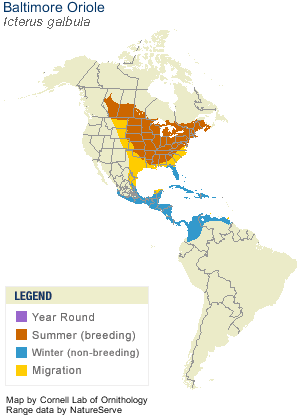
Northern (Baltimore) Oriole
With its brilliant orange and black plumage, the Baltimore Oriole’s arrival is eagerly awaited by birders each spring migration. Its preference for open areas with tall trees has made it a common inhabitant of parks and suburban areas.
Keys to identification
Typical Voice
[audio:http://backyardnaturalist.ca/wp-content/uploads/2011/05/oriole.mp3|titles=Baltimore Oriole]-
Size
7 to 8.25 in (18 to 21 cm)
-
Color Pattern
Male orioles have brilliant orange-golden underparts and shoulder patches, with black wings and a black head. Females are not as brightly colored. Though they are partially orange, they also have and brownish-olive plumage. Young male orioles do not achieve their adult plumage until autumn of their second year.
-
Breeding
Each spring a female oriole constructs a hanging nest at the end of a tree branch. From this perch, she will guard her eggs (typically four) for about two weeks. When the young birds hatch, both parents will feed and watch over them for an additional two weeks.
-
Habitat
These attractive birds frequent woodlands and eat common creatures including caterpillars and insects supplemented by fruits and berries. The Baltimore oriole’s appetite for caterpillars may help protect forests from some destructive pests. In the backyard, they can be enticed to visit feeders with oranges, nectars, or peanut butter.

